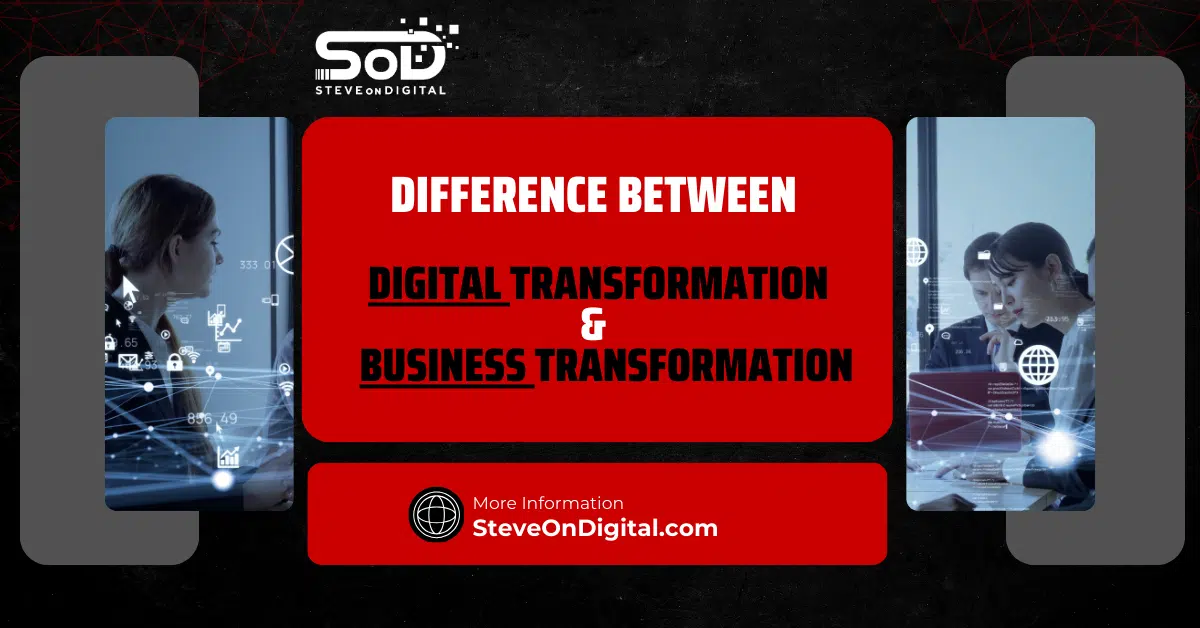An IT team, led by a visionary IT leader, can be more than just a support function; it can be a strategic partner that drives business growth. By integrating your IT team into strategic planning, you unlock potential for innovation and efficiency, making your business more competitive.
I’ve seen how transforming the IT team’s role from a cost center to a strategic driver can lead to significant improvements in business outcomes. This shift not only optimizes operations but also positions the business to thrive in a competitive landscape.
I’m Steve, a digital transformation expert with a strong background in electrical engineering, an MBA, and a master’s in Project Management. I excel at helping SMEs navigate the digital landscape with practical insights. Let’s begin!
Understanding the Roles of the IT Team
The IT team can wear many hats within an organization, each role defining the extent of its impact on business outcomes. From being a cost center to evolving into a strategic driver, the role of IT varies depending on how it’s perceived by senior leadership.
IT as a Cost Center
Traditionally, many companies, especially small businesses, view the IT department as a cost center. This means that the IT team is primarily seen as a necessary expense—its main function being to maintain current technology and ensure that the day-to-day operations run smoothly.
Transactional Relationship with Management
In this role, the relationship between IT and management is purely transactional. The IT team is tasked with implementing solutions that are often dictated from the top down. There’s little room for innovation or strategic input. I’ve seen this firsthand in several businesses I’ve consulted for, where IT was kept at arm’s length from any strategic decision-making. This leads to missed opportunities for leveraging technology to drive business growth. This transactional approach often overlooks the importance of maintaining relationships with existing partners and sponsors, which is crucial for long-term success.
IT as an IT Provider
Moving a step further, some businesses see their IT department as a provider of technology solutions. Here, IT isn’t just about keeping the lights on; it’s about enabling business needs and supporting various projects with the necessary tech resources.
Medium-Term Objectives and Limitations
However, even in this role, IT often remains largely reactive. The team may be allowed some degree of input and even permitted to experiment within certain limits. But the primary objective is still to meet the immediate and medium-term goals set by the business, without necessarily driving new strategies or innovations. This role reflects a scenario I encountered with a small e-commerce business, where IT was tasked with enhancing the website’s functionality but was not included in broader business planning.
IT as a Strategic Partner
Now, let’s talk about a role that truly unleashes the potential of the IT team: the strategic partner. Viewing the IT team as a strategic partner means recognizing the unique insights and capabilities that they bring to the table—insights that can shape the company’s future direction.
Inclusion in Strategy Meetings
In this role, the IT team isn’t just implementing someone else’s vision—they are actively involved in shaping it. Including the IT team in strategy meetings can be a game changer. Partnership leaders play a crucial role in ensuring that IT is included in these discussions, fostering a supportive corporate culture for effective strategic partnerships. When IT is part of the discussion, they can offer solutions that management might not even know are possible. I remember when I started including my IT lead in our strategy sessions; the ideas that emerged were game-changing, from automating marketing processes to improving customer experience through tech-driven solutions.
IT as a Strategic Driver
For businesses deeply rooted in technology, such as software companies, the IT team often takes on the role of a strategic driver. Here, IT doesn’t just support the business—it drives it.
Risk-Taking and Innovation
In this role, the IT team is encouraged to take risks and innovate. They’re not just maintaining current systems; they’re pushing the envelope to explore new technologies that could provide a competitive edge. This is particularly important in industries where technological advancements are rapid. Allowing the IT team the freedom to experiment can lead to breakthroughs that drive the entire business forward. For example, I’ve seen tech startups where the IT team’s ability to innovate was directly linked to the company’s growth and success.
The Strategic Value of IT in Business
Understanding the strategic value of IT is crucial for any business looking to stay competitive. IT is no longer just about keeping the systems running—it’s about driving business success through strategic use of technology.
Technology as an Investment, Not an Expense
One of the biggest shifts that needs to happen in small businesses is the perception of technology as an investment rather than an expense. This shift in mindset is critical. When I started viewing technology as an investment, I noticed that the return wasn’t just in improved efficiency, but in innovation and business growth. Investing in the right technology can lead to solutions that set your business apart from the competition.
Developing a Digital Roadmap
A digital roadmap is essential for aligning technology with your business goals. It’s about planning for the future and ensuring that your IT strategy supports your long-term objectives. In my experience, having a digital roadmap helped me stay focused on what mattered most, ensuring that our tech investments were not only effective but also aligned with our business strategy. A well-crafted digital roadmap is essential for managing strategic partnerships, ensuring that all technological initiatives are aligned with long-term business goals.
Enhancing Customer Experience through IT
Technology plays a pivotal role in improving customer experience. Whether it’s through automating customer service processes, enhancing your website’s user experience, or leveraging data analytics to understand customer behavior, IT can be a significant driver of customer satisfaction. I’ve seen firsthand how integrating IT into customer service strategies can lead to faster response times and more personalized service, which in turn boosts customer loyalty.
Building a Strong Partnership between IT and Senior Leadership
For IT to function effectively as a strategic partner, there needs to be a strong relationship between IT and senior leadership. This partnership is built on mutual respect, trust, and open communication.
Mutual Respect and Trust
Respect and trust are the foundation of any successful partnership. For IT to function effectively as a strategic partner, there needs to be strong relationships between IT and senior leadership, built on mutual respect, trust, and open communication. I’ve made it a point to build this kind of relationship in my business, and the results have been tremendous. When your IT team feels valued, they’re more likely to go above and beyond to deliver exceptional results.
Open Communication Channels
Effective communication is key to ensuring that IT and senior leadership are on the same page. Regular meetings, transparent discussions, and a shared understanding of business goals are essential. In my experience, fostering open communication has helped bridge the gap between IT and other departments, leading to a more cohesive and strategic approach to business challenges.
Strategic Thinking in IT
Encouraging strategic thinking within the IT team is vital. This means moving away from a purely technical focus and encouraging IT professionals to think about how technology can solve business problems and create opportunities. I’ve seen the benefits of this firsthand—when IT is empowered to think strategically, they can identify opportunities that others might miss.
IT as a Trusted Advisor
Ultimately, the goal is for IT to be seen as a trusted advisor within the business. This means that when strategic decisions are being made, IT’s input is not just sought after but valued. In my business, I’ve made sure that IT has a seat at the table, and it’s paid off in spades. The IT team brings a perspective that’s essential for making informed, strategic decisions.
Identifying and Capitalizing on Partnership Opportunities
Recognizing and capitalizing on opportunities where the IT team can serve as a strategic partner is vital for any business, especially in today’s tech-driven market. Through my experiences, I’ve seen how the right approach to IT can turn potential into reality, giving a business the edge it needs to succeed.
Deep Dive into Business Needs
The first step in this process is gaining a deep understanding of the business needs. I’ve learned that without a clear grasp of what the business truly requires, IT efforts can become misaligned, leading to wasted resources and missed opportunities. It’s essential to sit down with different departments, understand their pain points, and identify where IT can make a real impact.
By doing a deep dive into these needs, IT leaders can uncover hidden challenges that technology can solve. For example, I once worked with a small retail business that was struggling with inventory management. After thoroughly understanding their process, we implemented an automated inventory tracking system that not only saved time but also reduced costs significantly. This wouldn’t have been possible without a clear understanding of the business’s specific needs.
Leveraging Technology for Competitive Advantage
Once these needs are identified, the next step is leveraging technology to create a competitive advantage. Technology, when used strategically, can position a business ahead of its competitors. Strategic partners can leverage technology to create a competitive advantage, positioning the business ahead of its competitors. I’ve seen how small businesses, by smartly adopting technology, can level the playing field against much larger competitors.
For instance, in my own business, I used data analytics to better understand customer behavior. This allowed me to tailor marketing efforts more effectively, resulting in higher engagement and sales. It’s about using technology not just as a tool, but as a strategic weapon that drives the business forward.
Collaboration with Other Business Units
To truly capitalize on IT’s potential, collaboration between IT and other business units is crucial. In my experience, when IT operates in a silo, opportunities are missed, and solutions often fall short of their potential. It’s when IT and other departments work hand-in-hand that the magic happens. In some cases, collaboration can extend to joint ventures, which come with their own unique management challenges and opportunities for strategic alignment.
For example, I’ve worked on projects where IT collaborated closely with marketing to develop automated systems that streamlined campaign management. This collaboration led to more efficient processes and better outcomes for the entire company. It’s all about breaking down silos and fostering a culture of teamwork.
Measuring the Success of IT as a Strategic Partner
It’s one thing to position IT as a strategic partner, but measuring its success is another challenge altogether. Key performance indicators (KPIs) and continuous feedback are essential tools in this process.
Key Performance Indicators for IT
Identifying the right KPIs is critical to measuring IT’s contribution to business objectives. Over the years, I’ve come to rely on a mix of technical and business-focused KPIs. Technical KPIs might include system uptime or the speed of issue resolution, while business-focused KPIs could measure how IT initiatives contribute to revenue growth or customer satisfaction.
For example, in one of my previous projects, we tracked the impact of a new e-commerce platform that IT implemented. The KPIs included increased sales, improved customer retention, and reduced cart abandonment rates. These metrics provided clear evidence of IT’s value to the business.
Continuous Improvement through Feedback
Regular feedback is essential for ensuring continuous improvement in IT’s strategic role. I’ve always made it a point to gather feedback from all stakeholders after major IT initiatives. This feedback isn’t just about patting ourselves on the back—it’s about identifying areas where we can do better next time.
In one case, after launching a new CRM system, I gathered feedback from the sales team. Their insights led to several tweaks that significantly improved the system’s usability. Without this feedback loop, we might have missed the chance to make those critical improvements.
Aligning IT Metrics with Business Outcomes
To truly demonstrate value, IT metrics must align with broader business outcomes. It’s not enough to show that a system is running efficiently; it’s about how that efficiency translates into business success. Aligning IT metrics with business outcomes is crucial for demonstrating the value of strategic partnerships.
For instance, I’ve worked on aligning IT’s performance metrics with sales growth. By showing how IT’s efforts directly supported an increase in sales, I was able to secure further investment in technology from senior leadership. It’s all about connecting the dots between IT activities and the business’s bottom line.
Overcoming Challenges in IT-Business Alignment
Aligning IT with business strategies isn’t always smooth sailing. There are several challenges to overcome, from resistance to change to budget constraints. But with the right approach, these challenges can be managed effectively.
Managing Resistance to Change
One of the biggest challenges I’ve faced is managing resistance to change. When IT proposes new systems or processes, it’s not uncommon for employees to push back, fearing the unknown or the disruption to their routine.
To manage this, I’ve found that clear communication and involving users early in the process are key. When employees understand the benefits of a new system and feel that their input has been considered, they’re much more likely to embrace the change. For example, during the rollout of a new project management tool, I made sure to involve the project leads from the outset. Their buy-in was critical to the tool’s successful adoption.
Ensuring Consistent Delivery and Execution
Consistency is another critical factor in building trust and credibility for the IT team. I’ve seen how inconsistent delivery can quickly erode confidence in IT’s ability to serve as a strategic partner.
To avoid this, I always emphasize the importance of clear timelines, realistic expectations, and regular updates. In one project, where we were upgrading the company’s ERP system, maintaining consistent communication with all stakeholders ensured that everyone knew what to expect and when. This approach kept the project on track and minimized disruptions.
Navigating Budget Constraints
Finally, navigating budget constraints is a challenge that most IT teams face, especially in smaller businesses. However, I’ve learned that a limited budget doesn’t have to limit IT’s impact.
It’s about being strategic with spending—prioritizing investments that deliver the most significant return. For instance, in one of my previous roles, we faced tight budget constraints but needed to upgrade our cybersecurity defenses. By focusing on the most critical vulnerabilities and opting for scalable solutions, we were able to enhance security without breaking the bank.
Case Studies of Successful IT-Business Partnerships
One of the most effective ways to understand the power of IT as a strategic partner is by examining real-world examples. Through my experiences and observations, I’ve seen how different businesses have harnessed their IT teams to drive growth and innovation. Let me walk you through a couple of case studies that highlight best practices and offer valuable lessons.
Case Study 1: IT Driving Innovation in a Tech Company
In the fast-paced tech industry, innovation is key to staying ahead of the competition. I once consulted for a mid-sized tech company struggling to differentiate itself in a crowded market. They had a talented IT team, but the leadership viewed IT as more of a support function rather than a strategic partner. This limited the team’s ability to contribute to the company’s growth.
Recognizing this gap, I advised the company to shift their perspective and empower their IT team to take the lead in innovation. The IT team was integrated into the strategic planning process, allowing them to propose new technology-driven initiatives. One of the significant projects that emerged from this shift was the development of a cutting-edge software platform that streamlined customer interactions and data management.
The result? The company not only improved its internal processes but also created a product that set it apart from competitors. This project led to a 30% increase in customer retention and positioned the company as a leader in their niche. It’s a clear example of how viewing IT as a strategic partner can drive innovation and deliver tangible business results.
Case Study 2: IT as a Strategic Partner in a Non-Tech Industry
Not every business operates in the tech sector, but the principles of strategic IT partnerships apply across industries. I worked with a family-owned manufacturing business that had been operating for decades with little change in their processes. They were hesitant to invest in new technologies, viewing IT as merely a support function.
However, as the competitive landscape shifted, they realized the need to modernize their operations to stay relevant. I recommended a strategic partnership approach, where the IT team was given the mandate to explore and implement digital solutions that could enhance efficiency and reduce costs.
The IT team proposed a digital transformation initiative that included automating supply chain management and implementing real-time data analytics for better decision-making. This transformation resulted in a 25% reduction in production costs and a significant improvement in operational efficiency. The business not only survived but thrived, proving that IT can be a true strategic partner even in non-tech industries.
Lessons Learned from Successful Partnerships
These case studies highlight some key lessons that can be applied to other organizations:
- Empower IT with Strategic Responsibilities: Don’t limit your IT team to support functions. Involve them in strategic planning and give them the freedom to innovate.
- Invest in Technology as a Growth Driver: Viewing technology as an investment rather than an expense can open up new avenues for business growth.
- Foster Collaboration Across Departments: Ensure that IT collaborates closely with other business units. This synergy can lead to more effective solutions and better business outcomes.
These lessons reinforce the idea that IT is not just a back-office function but a vital partner in achieving business objectives.
Future Trends in IT as a Strategic Partner
As businesses continue to evolve, so too does the role of IT. Looking ahead, several trends will shape how IT functions as a strategic partner.
The Role of AI and Automation in IT Strategy
AI and automation are no longer just buzzwords—they’re becoming integral to how businesses operate. I’ve seen firsthand how these technologies can enhance IT’s strategic value. For example, AI-driven analytics can provide deeper insights into customer behavior, enabling businesses to tailor their offerings more effectively. Automation, on the other hand, can streamline processes, reduce errors, and free up valuable resources for more strategic tasks.
As we move forward, I believe AI and automation will play an increasingly important role in IT strategy. Businesses that embrace these technologies will be better positioned to stay competitive in a rapidly changing market.
The Increasing Importance of Cybersecurity
In today’s digital age, cybersecurity is more important than ever. With the rise of cyber threats, IT teams must prioritize security as a core component of their strategy. I’ve worked with businesses that underestimated the importance of cybersecurity, only to face significant financial and reputational damage from data breaches.
Going forward, IT teams will need to adopt a proactive approach to cybersecurity, implementing robust measures to protect sensitive data and ensure business continuity. This isn’t just about protecting the business—it’s about maintaining trust with customers and partners.
Preparing for the Digital Transformation
Digital transformation is no longer optional—it’s a necessity. I’ve seen how businesses that resist this change struggle to keep up with more agile competitors. IT teams must lead the charge in digital transformation, guiding the organization through the adoption of new technologies and processes.
To prepare for this, IT teams need to stay focused on emerging trends, invest in the right tools and technologies, and ensure that the entire organization is aligned with the digital strategy. The future belongs to businesses that can adapt and evolve, and IT will be at the forefront of this transformation.
Final Thoughts
Throughout this article, I’ve shared insights and experiences that highlight the importance of IT as a strategic partner in business. From identifying partnership opportunities to overcoming challenges, it’s clear that IT has the potential to drive significant value for any organization.
The key takeaway? Don’t underestimate the power of your IT team. By empowering them to take on a strategic role, you can unlock new opportunities, enhance efficiency, and ensure long-term success. As the business landscape continues to evolve, those who embrace IT as a strategic partner will be better positioned to thrive in the future.
Remember, the future of your business might just depend on how well you integrate your IT team into your strategic plans. Let’s make sure we’re ready for what’s next.




